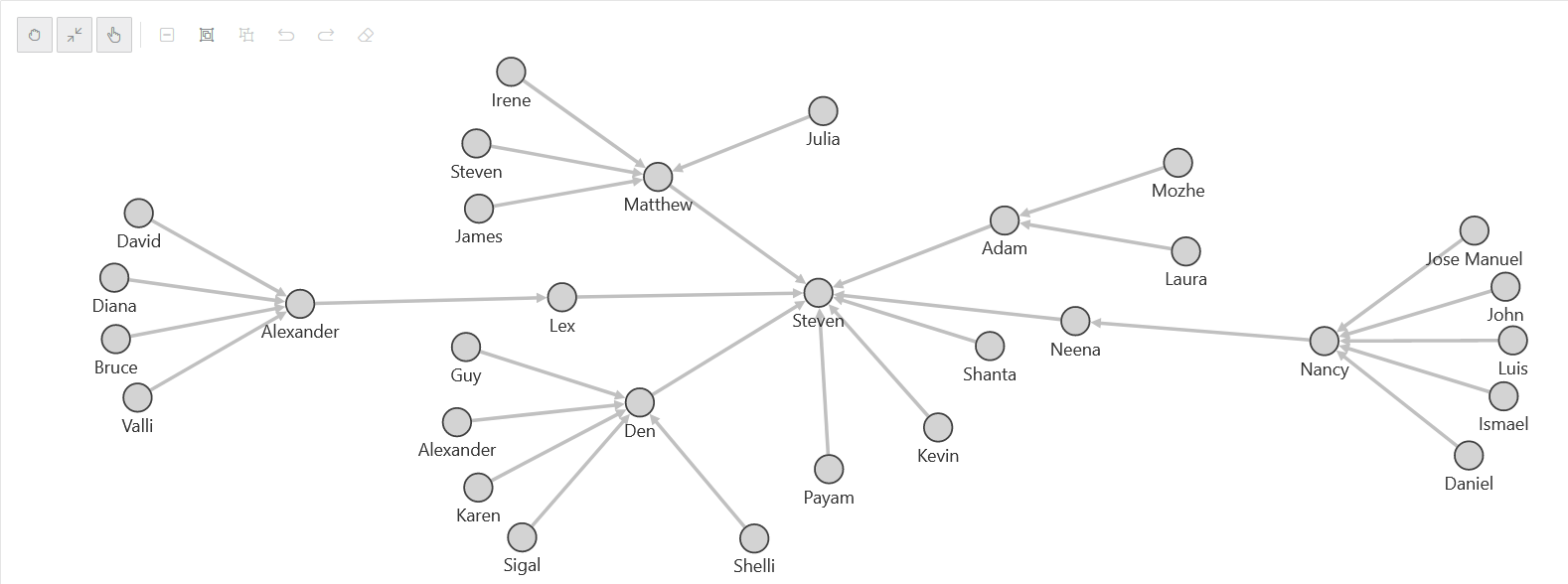Get Started with the APEX Graph Visualization Plug-in (Oracle Database 19c)
Get started with the APEX Graph Visualization plug-in in your APEX application on your Autonomous AI Database instance using Oracle Database 19c.
Before you begin, ensure that you meet the prerequisites described in
Prerequisites for Using the APEX Graph Visualization Plug-in.
- Download the Graph Visualization (Preview) plug-in from Oracle APEX GitHub repository.
- Sign in to your APEX workspace in your Autonomous AI Database instance.
- Import the downloaded plug-in script
(
region_type_plugin_graphviz.sql) file into your target APEX application by following the steps in Importing Plug-ins in the Oracle APEX App Builder User’s Guide. - Implement the plug-in in an application page to perform graph
visualization.The following basic example describes the steps to visualize a graph existing in your Autonomous AI Database instance using the Graph Visualization plug-in.
- Open the application page in Page Designer.
- Select the Rendering tab on the left pane of the Page Designer.
- Right-click an existing component and add a new region component.
- Select the new region and configure the following attributes
in the Region tab of the Property
Editor on the right pane of the Page Designer:
- Enter the Identification Title.
- Select Graph Visualization (Preview) as Identification Type.
- Select the source Location as Local Database.
- Select Type as SQL Query.
- Run a SQL query, which wraps a PGQL query in the
ORA_PGQL_TO_JSONPL/SQL function, to retrieve the graph data.For example:
SELECT ORA_PGQL_TO_JSON(query => 'SELECT e FROM MATCH (e:employees) ON OEHR_EMPLOYESS LIMIT 20') FROM DUAL;It is important to note the following:
- The plugin accepts the input graph data
containing the vertex and edge information in JSON
format only. This is supported by the
ORA_PGQL_TO_JSONPL/SQL function which takes a PGQL query as input and returns the graph output in JSON structure. - The graph referenced in the PGQL query must exist in your Autonomous AI Database instance.
- The plugin accepts the input graph data
containing the vertex and edge information in JSON
format only. This is supported by the
- Run the application page to visualize the graph rendered by
the plug-in.

Description of the illustration apex_basic_graph.png
- Optionally, if you wish to implement pagination in the preceding graph
visualization, then perform the following steps:
- Switch ON the SQL Query Supports Pagination setting in the Attributes tab of the Property Editor for the graph visualization component in your APEX application.
- Bind the
page_startandpage_sizeparameters when calling theORA_PGQL_TO_JSONfunction in the SQL query as shown in the following example code:SELECT ORA_PGQL_TO_JSON(query => 'SELECT e FROM MATCH (e:employees) ON OEHR_EMPLOYESS LIMIT 20',:page_start,:page_size) AS result FROM DUAL; - Set the Page Size value in the
Attributes tab of the Property Editor.Note that the page_start value is automatcially set.
- Save and rerun the application page.The graph gets rendered with pagination.
- Optionally, download the Sample Graph Visualizations application from
Oracle APEX GitHub
repository.This application demonstrates the use of the Graph Visualization plug-in.
- Import the downloaded
sample-apps/sample-graph-visualizations/sample-graph-visualizations_19adb.sqlinto your APEX instance by following the steps in Importing an Application. - Run the sample application from the application home page in App Builder.
- Import the downloaded